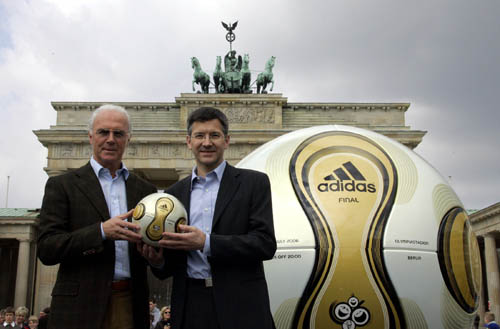With the World Cup 2006 now history, sporting
goods maker Adidas AG said it will not bask for long in the success,and
buzz,that its Teamgeist ball generated.

Franz Beckenbauer,
President of Germany's World Cup organising committee, and Adidas CEO
Herbert Hainer (R) hold a golden soccer ball during a presentation next to
the Brandenburg gate in Berlin April
18.[filephoto] |
The ball, designed solely for the World Cup and debuted in December 2005, has
drawn plenty of comment, criticism and praise from players, coaches, pundits and
customers for its unique design style and its effectiveness on the field.
But don't expect to see its aerodynamic form and glossy, polyurethane-coated
surface being kicked into the net at all of the world's big league soccer games,
except for the UEFA Champions league and on the fields of teams such as Bayern
Munich, of the German league, and AC Milan.
"This is actually an expansion of the contract that we already had with the
Champions League," Thomas Van Schaik, the company's director of global football
public relations, told The Associated Press Monday. "We were the supplier, but
now, as of this season every Champions league title game will be played with
this ball."
Other leagues will also sport Adidas-made balls, many incorporating the new
design aspects of the Teamgeist, including the United State's Major League
Soccer.
"The Teamgeist is also the official matchball of Major League Soccer in the
U.S," said Adidas spokesman Jan Runau. "So, yes, it is and should become the
ball of choice on all levels of football."
While the ball won't be the exclusive product for other leagues worldwide,
consumers can get their hands on it at most retail outlets that carry Adidas'
shoes, shirts and more.
But it's not cheap.
Since its debut in December, Adidas has sold about 15 million of the
Teamgeist,German for "team spirit",14-panel balls, at a price that has ranged
from US$113 to US$138 (euro88 to euro110).
The figures beat the company's initial expectations of 10 million sold and is
more than twice the 6 million Fevernova balls it sold during the 2002 World Cup.
Van Schaik said Adidas, which is the exclusive supplier of balls for FIFA and
the World Cup, is already working on a new design for the Euro 2008
championships, to be held in Austria and Switzerland, as well as one for the
2008 Summer Olympics in Beijing. It is also an official sponsor for the World
Cup in 2010 and 2014.
Those are expected to take elements from the Teamgeist design, but,
naturally, he wouldn't say what or how.
Players at the World Cup have given the Teamgeist ball a mixed reception.
Some say its design makes it travel farther when kicked, while goalkeepers have
grumbled that it is harder to stop.
Van Schaik made no apologies for that, either.
"The one thing that is crucial is that we develop products to enhance
performance. You will not simply see a ball from Adidas that is faster or
lighter. We want to create products help the best players play better," he said.
Adidas has developed balls for every World Cup tournament since 1970, when it
debuted the Telstar with its array of 12 black pentagons and 20 white hexagons,
now an icon in the sporting world.
The company said the 2006 tournament should help provide more than euro1.2
billion (US$1.5 billion) in revenue from soccer-related products, including
shoes and replica jerseys. In all of 2005, Adidas had euro6.6 billion in sales,
with euro434 million in profit.